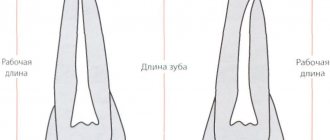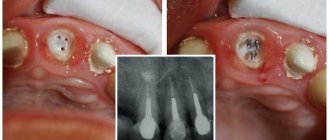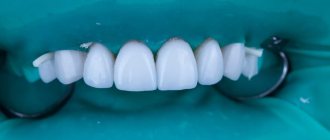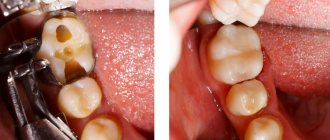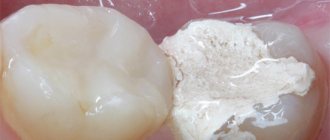Sometimes situations arise when it is necessary to refill a dental canal. The reasons for such cases may be different. For example, poor-quality root canal filling, incorrect identification of the source of infection during initial treatment. In addition, the structure of the patient’s tooth or a violation of the tightness of the installed filling also affects the result of tooth treatment. We will tell you about the reasons for the need to refill a tooth and the rules for its implementation to obtain a reliable result.
Features of the procedure for re-treatment of a dental canal
Refilling the canal of a previously treated tooth is a special case in the practice of dentists. Before doing this, it is necessary to remove the old filling, clearing the entire dental canal of the filling material. During such work, the flexible rod may break. This will somewhat complicate the dental treatment process.
Typically, this problem occurs with a very dense filling that is closely adhered to the walls of the canal of the tooth being treated.
Difficulty also arises if it is necessary to refill curved dental canals. When cleaning such channels, you can damage their walls or even break the instrument. Such situations require increased attention from the specialist to ensure high-quality completion of the canal filling. Specialists are required to inform the patient about possible difficulties during treatment before the procedure.
Repeated root canal treatment is a necessity for many patients
Quite often, patients come to our clinic to replace an outdated filling on a tooth that previously underwent root canal treatment. However, on the x-ray that we take before replacing the filling in such teeth, we see that root canal retreatment is required. The canals could have been healed many years ago, and the patient is sure that everything is fine with them, and the tooth will last for a long time, but this is not at all the case. If the root canal is poorly sealed, then an inflammatory focus appears on the root of the tooth, possibly even a cyst - this problem must be solved.
If you do not treat the channels in which such problems exist, serious consequences are possible. On the upper jaw there are the maxillary sinuses, large choroid plexuses, organs of hearing, organs of vision, and in the lower jaw there is the large mandibular nerve. All this can be involved in the inflammatory process, a serious complication can also go to the brain. Patients are often surprised by the scale of the problem and the size of the inflammatory focus. When studying a computed tomogram, ENT problems are often simultaneously identified that patients were not aware of.
I would like to draw special attention to the fact that patients may not be bothered by anything
. They come not with pain or with an immediate desire to treat canals, but with the goal of changing a filling, restoring a chip, and preparing for prosthetics.
In what cases is root canal retreatment required?
Previously, root canals were mainly filled with medicinal pastes, including resorcinol-formalin, which changed the color of the tooth pink. Over time, it turned out that this paste is loose, voids can form in the root canals, and inflammatory foci appear on the root.
There are other types of pastes that do not change the color of the tooth, but over time, the material in the root canal also becomes more loose, voids appear, which are a favorable environment for the development of infection, resulting in inflammatory foci. As soon as a filling defect occurs, saliva begins to flow into the canal, which further aggravates the situation: infection of the canal accelerates, the infection goes into the bone.
The next method of canal filling was the lateral condensation method - filling the root canals with cold gutta-percha. Together with the medicinal paste, several gutta-percha cones are inserted into the canal; the cones are pressed against one another and create a dense root filling.
What is considered a high-quality canal filling?
The canal must be sealed to the apex of the root. The material on the x-ray should look homogeneous, without voids, from beginning to end of the same color, the same consistency, there should be the same radiopacity, the bone around the top of the tooth should not contain signs of inflammation.
The vertical condensation method - filling root canals with hot gutta-percha - is modern and at this stage of development of dentistry the most reliable method of root canal treatment. Hot gutta-percha is introduced into the heated canal, taking the internal shape of the canal, repeating its relief. Hot gutta-percha practically does not shrink, and this is a guarantee that the canal will remain tightly sealed and there will be no voids in it, since the resorption of the medicinal paste is minimized. All this leads to the fact that penetration of any infection into the bone becomes impossible.
The durability and reliability of hot gutta-percha should be noted. I started working with the vertical condensation method in 2002 and constantly monitor my patients whose canals were treated using this method. On x-rays we see that the root filling remains complete and of high quality, there are no inflammatory foci on the root or on the apex of the tooth, the bone is preserved, the root is preserved, the patient only needs to change the filling or crown to recreate the anatomical shape of the tooth.
Why use a microscope during root canal retreatment?
The resolution of our eye is much less than the resolution of a microscope, and without special magnification it is simply impossible to see the anatomy of the root canal, and, accordingly, to treat it efficiently. This is often where the need for retreatment lies: the doctor did not use magnification during the initial treatment, did not see all the nuances, did not go through the canal correctly, and did not completely fill it. Since there were voids in the canal and the paste became loose over time, the infection filled the entire canal and entered the tooth bone. No doctor can predict the anatomy of a patient's tooth, since all teeth are very different, even in the same patient.
What difficulties and risks are associated with root canal retreatment?
Although primary root canal treatment is certainly a complex and extremely responsible process, retreatment is associated with more significant risks. A previously treated tooth had already been subjected to mechanical stress, which could have an unpredictable effect on the situation in the tooth. Therefore, it is doubly difficult for the dentist performing retreatment, and the risks during such treatment are quite high, therefore, retreatment of canals can only be trusted by very experienced endodontists (specialists in the treatment of root canals); retreatment should occur exclusively using a microscope.
Do patients come on their own initiative for root canal retreatment?
Patients rarely come to the clinic for the purpose of root canal retreatment, since this problem usually does not make itself felt in any way and is clarified only after an x-ray. We tell patients about the risks that teeth with poorly filled canals are exposed to, the main of which is the possible loss of a tooth and the need to install an implant. The patient weighs the financial and time costs and makes a decision, generally agreeing to re-treatment of the canals - after all, preserving his own tooth is always a priority. It is important to understand: if there is a problem in the root canal, it will never go away on its own. The infection, which has begun to spread in the canal, absorbs the filling material, then begins to affect the bone and destroy the internal walls of the canal, the tooth weakens from the inside. Thus, tooth retreatment should under no circumstances be delayed if there is a desire to save the tooth.
Our main recommendation to all patients: go for preventive examinations to the dentist at least twice a year, have your teeth professionally cleaned, in this case you can prevent the development of serious problems in the oral cavity.
Clinical cases of patients:
Before treatment: the root canals are not completely filled. There are pockets of inflammation in the bone around the roots of the teeth
After treatment: complete filling of the root canals. Bone tissue restoration is noted.
Before treatment: the root canals are not completely filled. There are pockets of inflammation in the bone around the roots of the teeth
After treatment: complete filling of the root canals. Bone tissue restoration is noted.
Commenting system SigComments
Back to section
Why undergo a dental canal refilling procedure?
There are several reasons why you need to re-treat a dental canal:
- persistence or resumption of pain after filling;
- X-ray shows the presence of inflammation;
- incomplete closure of dental canals.
In addition, complications may result from errors or inaccuracies that arose during treatment. For example, when preparing the canal for treatment, an infection was introduced, access to the base of the canal is impossible, or there are pathological holes in the walls of the tooth or its bottom. In addition, no one is immune from the mistakes of the doctor performing root canal treatment.
When treating a dental canal before filling, the following problems most often occur:
- Dentim gets into the sawmill,
- the middle part of the canal is greatly expanded,
- tool failure,
- the integrity of the root walls is compromised.
When filling a canal, the main problems arise if it is not completely filled, the filling material extends beyond the hole, or there is a longitudinal fracture at the root of the tooth. Medical errors are also possible at this stage - the doctor may incorrectly estimate the length of the canal or not completely clean it. This may contribute to the development of inflammation.
Dentist advice: how to determine how well the canals are filled?
If you have extensive carious lesions on your tooth or inflammatory processes (pulpitis, periodontitis), then, unfortunately, removal of the nerve from the diseased tooth cannot be avoided.
And at the same time, filling the canals. Root canal filling is a complex and responsible procedure. And not only because the doctor must carry out all manipulations with high precision and caution.
Even if the operation went without surprises, after a while you may encounter very unpleasant complications.
And in 60%-70% of cases, the cause of these complications is poor-quality canal filling!
The consequences of such treatment may be:
- severe toothache due to “overfilling” - when excess filling material extends beyond the upper border of the canal;
- gumboil, the development of acute abscesses, the appearance of cysts on the tooth due to “underfilling” of the canals - then an infection develops in the voids of the canal;
- complete tooth removal , which is caused by inaccurate treatment of the canals before filling and perforation of the root wall.
First of all, let's figure it out -
How does the process of refilling dental canals take place?
The current level of development of medicine in the field of dentistry is quite high. But dentists make mistakes, which is why filling dental canals again is quite common. At this point in time, doctors use several methods for performing this procedure.
Mechanical methods involve the use of a special instrument - an endodontic motor and an apex locator. In this case, antiseptic agents are added to the filling material. To prevent the development of inflammation, the doctor must very carefully and completely fill the dental canal with filling material.
Medicinal methods involve the use of products with organic solvents. They are able to soften and destroy the filling in a few minutes.
The cement filling can be removed from the canal using ultrasound and an endo-nozzle. This canal cleaning is usually carried out in one procedure.
Complications after root canal filling
If a filled tooth hurts after visiting the dentist, there is a high probability of complications. Filling is most often used in the treatment of caries and pulpitis, poor treatment of which can stimulate the progression of the disease and the occurrence of pain.
If after filling there is pain in the problem tooth, treatment will be carried out depending on the cause of the complication. One of the reasons for the complication is insufficient treatment of the tooth before filling. Treatment for such a complication consists of removing the filling, cleaning the problem areas and re-filling.
After treatment of caries, if the doctor is insufficiently qualified, the following unpleasant consequences are possible:
- enamel damage;
- pulp burn during tooth preparation;
- acid contacting dentin.
After canal filling, the following complications may occur:
- Perforation of the root wall. Symptoms of perforation upon examination include instrument failure, pain, and bleeding. Treatment in this case begins with studying the situation in the root lumen on an X-ray image. Then the perforation is closed with cement or other filling material.
- Insufficient antiseptic treatment can cause infection. Needs to be re-treated.
- The development of infection in the tooth as a result of incomplete filling of the canal with filling material. Treatment is repeated cleaning and refilling.
- Extension of filling material beyond the root apex. Depending on the intensity of pain and sensitivity of the patient, there are two options: at the stage of painful sensations, take painkillers or re-treat the tooth.
- Reaction to temperature changes in a canal missed during filling.
- Pain due to a broken instrument in the canal. The fragment is easily detected on x-ray. This tooth often needs to be removed.
- The appearance of a cyst or granuloma after improper canal treatment.
- Periodic inflammation of the gums, formation of gumboil or fistula due to dental canal treatment performed incorrectly.
- Change in tooth color due to improper treatment.
- Due to a poorly treated canal and an inflamed abutment tooth, replacement of a high-quality denture is often required.
- Loss of a filling due to an inaccurate procedure. Refilling required.
- An allergic reaction to filling materials can occur due to the characteristics of the body.
Interesting fact
The widespread use of implants in modern dentistry became possible thanks to Professor Ingvar Brånemark from Sweden, who in 1965 discovered osseointegration - the process of healing and fusion of bone tissue with a titanium implant. The bioinertness of titanium practically eliminated its rejection by the body.
The first “dentists” were the Etruscans. They carved artificial teeth from the teeth of various mammals as early as the 7th century BC, and also knew how to make bridges strong enough for chewing.
Modern technologies in the field of tooth refilling
Dental treatment under a microscope is one of the newest services that has appeared in dentistry. High-tech equipment allows specialists to fill the dental canal with better quality, more accuracy and efficiency. Thanks to the use of such a device, the likelihood of causing harm to healthy tissue is close to zero. In addition, the treatment is carried out very delicately. Microscope glasses allow you to view the tooth at multiple zooms. This will allow you to see all the affected areas that may simply not be visible during normal examination.
A microscope allows dentists to perform root canal treatment faster and safer for the patient.
Painful sensations under an old filling
A situation familiar to many: a tooth was filled a long time ago, it didn’t bother me for a long time, and then it started to hurt. There are several possible reasons:
- progressive caries under an old filling;
- pulpitis (inflammation of the dental nerve) , developing as a result of untreated caries. Often this is a chronic form (periodically occurring paroxysmal pain in a tooth under a filling). Attacks occur most often at night. If left untreated, periodontitis will develop and the roots of the tooth will become inflamed;
- Periodontitis is a common cause of tooth pain under a filling. This is an inflammatory process in deep tissues. The slightest touch to a sore tooth causes terrible pain. It can radiate to the ears, head (temples and back of the head). Read on for details about why your tooth hurts and radiates to your temple. In this case, immediate assistance from a dentist is necessary. The old filling needs to be removed and the canals cleaned. The dentist places special preparations in the prepared and expanded canals that will relieve inflammation and disinfect the tooth cavity. Medicines are usually added twice. When the inflammation is removed, the doctor places a new filling. If the roots are inflamed, tooth treatment until complete recovery can be extended even for several months;
- tooth cyst It can develop over a period of time, from several months to several years. At first there are no sensations. Only in advanced cases does the tooth hurt. The cyst can lead to tooth and jaw destruction. In addition to toothache, signs of a dental cyst may include migraine, weakness, sinusitis, high fever;
- violation of the marginal seal of the filling. For various reasons, for example, due to abrasion or shrinkage of the material, the marginal fit of the filling is disrupted. Micro-cracks form between the filling and the tooth wall, where bacteria, saliva, and food debris enter. Dentin becomes infected, inflammation occurs, and recurrent caries or pulpitis develops.
- root crack. Occurs with heavy chewing load, injuries, or fixation of pins. The crack is difficult to detect, but after a while a complete vertical fracture may form in its place. The crack is difficult to diagnose, but causes pain or discomfort when stress is placed on the tooth.
A sign of the formation of a crack in the root may be a “click” heard by the patient during fixation of the pin or condensation of gutta-percha. As a rule, they remember about him after a while.
For more information regarding the causes of pain in a filled tooth, watch the video
Removing the seal under the anchor pin
Obturation of the tooth root canal is done in parallel using anchor pins. If the filling in the lower part of the root is placed correctly and hermetically, then it is left to install the pin structure. This procedure is carried out over two trips to the dental office.
On the first day, the doctor treats the dental canal mechanically, softens the filling with medications and cleans the passage with an endo-instrument. The doctor then soaks a cotton swab in the medicine and inserts it into the canal. The patient takes the medicine for a couple of days and then makes another visit to the doctor, during which the cotton swab is removed and the canal is refilled.
Pain after root canal treatment
It happens that after root canal treatment, the molar should completely lose sensitivity. If pain in the tooth remains after removal of the nerve, then you need to continue therapy. Possible causes of the disease:
- The dental instrument used to clean canals is very thin. There are times when part of it breaks off and remains in the canal as a foreign object. An X-ray after filling is also needed to determine the boundaries of the filling. It is worth making sure that there is no unsealed space left in the canal. Incomplete filling will lead to inflammation and spread of infection in the tooth;


